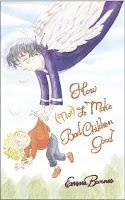 I love writing about naughty children. I loved reading about their exploits as a child – whether it was Anne of Green Gables walking the roof-pole, Daisy Bagthorpe setting fire to the dining-room, or Laura Ingalls giving her prissy sister a good slap. So naturally I wanted to create my own fictional little demon.
I love writing about naughty children. I loved reading about their exploits as a child – whether it was Anne of Green Gables walking the roof-pole, Daisy Bagthorpe setting fire to the dining-room, or Laura Ingalls giving her prissy sister a good slap. So naturally I wanted to create my own fictional little demon. But writing about naughty children is harder than it looks. Too wild – and the adult world of parents and schools will be down upon you. Too tame – and your readers will lose interest. And unfortunately that balance is harder to find now than it has ever been.
How so, I hear you say. Isn’t children’s literature more embracing, and less preachy, than it has ever been?
Not really. Just look at this example:
A boy keeps kicking footballs over the garden fence. His crusty neighbour refuses to give them back. So that night he dons a mask, and breaks into her house. He finds the ball in her living-room, and when she comes into the room, he pretends to have a gun and threaten her, thus making his escape. She reports the incident to the police – exaggerating the circumstances – and he blackmails her into never keeping his ball again.
Which child is this? Horrid Henry or Dirty Bertie? No. This school boy rogue is Just William. First appearing in print in the 1930s, naughty William is able to do things that no contemporary child hero would be able to get away with. (Leading a gang, and regularly setting fire to things, being two others I can think of.) Naughty William may still be in print – but only because he is so wrapped around in the glow of nostalgia. Otherwise, just imagine the outcry!
For all the talk about liberal parenting, and “anything goes”, it just ain’t so. Most modern
 children do not go far afield compared to previous generations; they do very little without adult supervision. And horror of children running amok will be even greater after the recent riots. If you want to write about a contemporary child is a realistic setting you have to take this into account.
children do not go far afield compared to previous generations; they do very little without adult supervision. And horror of children running amok will be even greater after the recent riots. If you want to write about a contemporary child is a realistic setting you have to take this into account. And yet every new generation needs new anti-heroes. They need to see child heroes push the boundaries – if only in fantasy-land. It’s an form of escape. And it’s good fun.
So, how to make it work? Here are some thoughts – using as examples some wonderful, classic anti-heroes.
1) Keep the protagonist young.
Younger children have the “Get Out of Jail Free” Card in that they can’t be blamed. Judy Blume’s Fudge falls into this category. When he eats his older brother’s pet turtle, it’s OK, because he really doesn’t know any better.
2) Keep it to home and school.<
7 Comments on How Bad Can You Get?, last added: 8/22/2011
Display Comments
Add a Comment



This is very thought-provoking, Emma.
I think the issue has become more complex because the way we discipline children has changed.
In the past, a child who burnt down a shed - an action more dangerous and destructive than the label 'naughty' suggests - would expect a good beating at the very least. Perhaps that put really bad behaviour into the realm of fantasy and escapism for most kids. But now it might result in a stern talk about respecting the property of others and endangering the self it is more of an option - and so less acceptable in fiction, perhaps?
Interesting post, Emma. Just William for me, I guess. Despite the bad reviews (by adults) the most recent BBC adaptation had our four year old granddaughter glued to the screen, her mouth wide open in disbelief.
Spot on, Emma! We often listen to William audiobooks (read by the incomparable Martin Jarvis) on long journeys, and more than once I've thought, "You'd never get away with that these days!"
Really interesting, Emma. I used to love Jennings and Darbishire as a child, but now would probably opt for William - very much enjoyed the tapes with our kids.
I'd never thought about this but you're quite right. That was a great post, very thought-provoking.
Like Sue, I loved the Jennings stories. But I never got on with Just William, for some reason. I also loved Katy in the Susan Coolidge books.
Hello Stroppy - actually the children who burned down the shed (the Herdmanns) got away with it - they even got some dough-nuts, as they snaffled the ones sent over for the police! But, the authors explained, they were lucky - they burnt down a shed everybody hated and thought should be condemned. (I don't know how she got that past her editors - and American editors too, especially alert for the moral messages.)
I loved the recent Just William adaptation, but like Sue and Nicola, I have always loved Jennings more...I wish the BBC would make a TV adaptation of them. They are pure genius! And today's children still enjoy them...when they are given the chance.
Just William, absolutely! Though maybe I should revist Jennings...